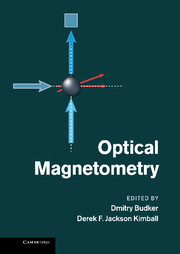Book contents
- Frontmatter
- Contents
- List of contributors
- Preface
- Part I Principles and techniques
- 1 General principles and characteristics of optical magnetometers
- 2 Quantum noise in atomic magnetometers
- 3 Quantum noise, squeezing, and entanglement in radiofrequency optical magnetometers
- 4 Mx and Mz magnetometers
- 5 Spin-exchange-relaxation-free (SERF) magnetometers
- 6 Optical magnetometry with modulated light
- 7 Microfabricated atomic magnetometers
- 8 Optical magnetometry with nitrogen-vacancy centers in diamond
- 9 Magnetometry with cold atoms
- 10 Helium magnetometers
- 11 Surface coatings for atomic magnetometry
- 12 Magnetic shielding
- Part II Applications
- Part III Broader impact
- Index
7 - Microfabricated atomic magnetometers
from Part I - Principles and techniques
Published online by Cambridge University Press: 05 May 2013
- Frontmatter
- Contents
- List of contributors
- Preface
- Part I Principles and techniques
- 1 General principles and characteristics of optical magnetometers
- 2 Quantum noise in atomic magnetometers
- 3 Quantum noise, squeezing, and entanglement in radiofrequency optical magnetometers
- 4 Mx and Mz magnetometers
- 5 Spin-exchange-relaxation-free (SERF) magnetometers
- 6 Optical magnetometry with modulated light
- 7 Microfabricated atomic magnetometers
- 8 Optical magnetometry with nitrogen-vacancy centers in diamond
- 9 Magnetometry with cold atoms
- 10 Helium magnetometers
- 11 Surface coatings for atomic magnetometry
- 12 Magnetic shielding
- Part II Applications
- Part III Broader impact
- Index
Summary
Introduction
In this chapter, we discuss miniaturized atomic magnetometers, and the technology and applications relevant to this somewhat unusual direction in magnetometer research and development [1]. By “miniaturized,” we mean, in addition to their small size, magnetometers that have associated desirable qualities such as low power consumption, low cost, high reliability, and the potential for mass fabrication. Together with the high sensitivity usually obtained from the use of atoms, these properties result in magnetic sensors that fill a unique application space and may in fact enable new applications for which atomic magnetometers have not before been used.
It is perhaps surprising that atomic magnetometers in general are not more widely used in the world today. The main application areas at present are geophysical surveying and magnetic anomaly detection. Geophysical surveying is important in oil and mineral exploration, archeology, and unexploded ordnance detection and is typically carried out by moving one or more atomic magnetometers over the area to be surveyed. The magnetic “map” generated from this data can show the locations and in some cases the size and shape of magnetic objects or structures buried beneath the surface of the earth. Magnetic anomalies include vehicles, ships, and submarines and are typically detected via magnetic gradiometry. There are, however, only three major companies in North America, employing perhaps a few hundred people, that manufacture and sell atomic magnetometers. This effort represents a rather small fraction of the worldwide yearly market for magnetic sensors, which was estimated in 2005 to be about §1 billion [2]. Commercial atomic magnetometers are described in Chapter 20.
- Type
- Chapter
- Information
- Optical Magnetometry , pp. 125 - 141Publisher: Cambridge University PressPrint publication year: 2013
- 1
- Cited by



